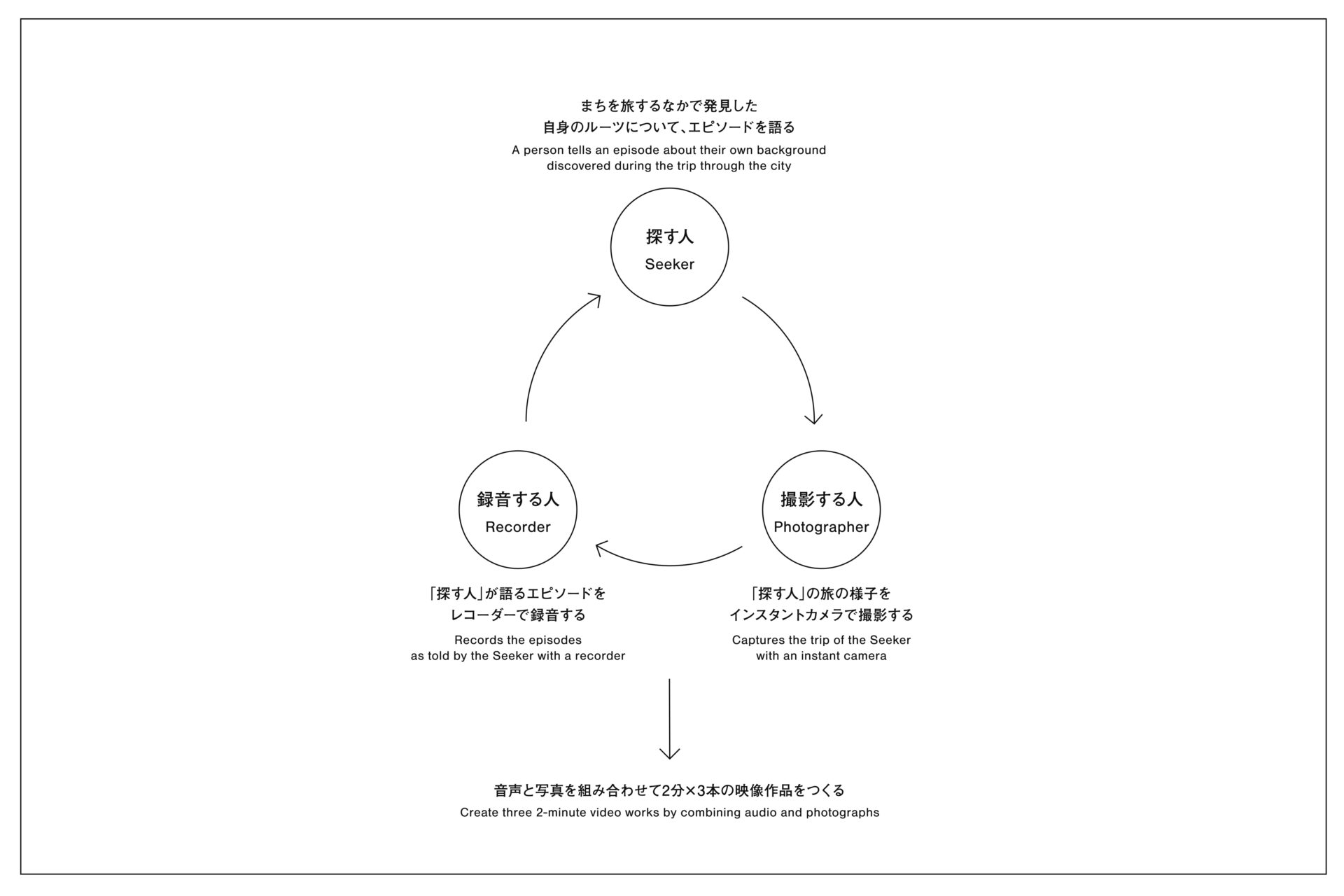
手法1:シネマポートレイトMethod 1: Cinema Portrait
シネマポートレイトのルールThe rule of Cinema Portrait
参加者たちはまちのなかで自身のルーツを探す小さな“旅”をする。まちを歩き、自身のルーツとリンクする風景に出会ったら、その場所/瞬間が想起させたエピソードを語る。そして、3人1組で以下の3つの役割をローテーションしながら、それぞれの旅を記録する。
・探す⼈:まちで発見した自身のルーツについてエピソードを語る
・録⾳する⼈:「探す⼈」が語るエピソードをレコーダーで録⾳する
・撮影する⼈:「探す⼈」の旅の様⼦をインスタントカメラ(10枚)で撮影する
旅の終了後、記録した⾳声と写真を組み合わせて映像作品をつくる。参加者たちは撮影した写真の順番を決め、録音した音声のなかで使用する部分を選ぶ。その際に、1人で1作品をつくるのではなく、グループ間で意見を出しながら3人で3作品をつくることを意識する。写真の順番と音声の使用部分が決定したら、それに沿って運営スタッフが編集を仕上げ、各2分の映像作品を完成させる。Participants will take a small trip to find their own background in the city. As they walk through the city and encounter landscapes that link to their own background, they will tell episodes that the place and/or moment reminded them of. Then, in groups of three, each person will record their own trip, rotating between the following three roles:
- Seeker: Tell episodes about their own backgrounds found in the city.
- Interviewer: Recording the episodes as told by the Seeker
- Photographer: Take ten photos of the Seeker on their trip with an instant camera.
At the end of the trip, the participants will create video works by combining the recorded audio and photographs. The participants will decide the order of the photos taken and select the parts of the recorded audio to be used. The participants keep in mind that they are not creating a work of their own just by themselves, but rather three works all made by three people, while sharing their opinions among the group. Once the order of the photos and audio portions have been decided, the management staff will edit the video accordingly to complete a video work of two minutes each.

シネマポートレイトの作品The works of Cinema Portrait
「シネマポートレイト」は「Multicultural Film Making(MFM)」にて初めて開発したも ので、KINOミーティングではそれをブラッシュアップしながら引き続き実施してい る。主にワークショップの最初に行うプログラムであり、参加者たちは会って間もな いルーツの異なる他者とグループを組んで作品制作に臨むことになる。しかし、まち を歩きながら、自らの個人的なエピソードを語り、立場を交換して他者の話を聞くと いうプロセスは、作品制作のための行為を越え、参加者同士の関係構築につながる。
参加者が語るエピソードは、自身の生い立ちに関すること、大切な人との関係性、自身 の未来のこと、そしてふと思い出した些細なことまでさまざまである。そして、その 語り自体もアクセントのある日本語で話されたり、途中で英語や中国語などそれぞれ が得意とする言語に切り替わったりすることがある。その揺らぎと振れ幅からは、そ の人のルーツ(roots)はある一点の場所に属するものではなく、その人が辿ってきた ルート(routes)によって、複数の要素が混在しているものであることが見えてくる。
作品では、そのような別の場所/時間についての語りが、その日に撮影した東京の風 景に重なってくる。それらの間に生まれる乖離は、地理的/時間的な複数のレイヤー を生み出し、視聴時にはその間を行き来する特異な映像体験をもたらす。“Cinema Portrait” was first developed in the Multicultural Film Making (MFM) workshop, and continues to be conducted, with improvements, in KINO Meeting. This program tends to be conducted at the beginning of the workshop, where participants work in groups with others from different backgrounds whom they have just met. However, the process of walking through the town, telling their own personal episodes, exchanging roles, and listening to others' stories goes beyond the act of creating an artwork, and leads to the building of relationships among the participants.
The episodes told by the participants vary from their own personal history, relationships with the people that are important to them, their own future, and even trivial things that they suddenly were reminded of. The narratives themselves are sometimes spoken in accented Japanese, and then may occasionally switch to English, Chinese, or other languages in which they are proficient. The fluctuations and swings reveal that their backgrounds do not lead to a single point, but are a mixture of multiple elements, depending on the routes they have taken.
In the completed video works, such narratives about places and times they’ve spent outside of where they are now overlap with the landscape of Tokyo photographed that day. The divergence created between them creates multiple geographical and temporal layers, and when viewed, the viewer experiences a peculiar visual experience of moving back and forth between them.

